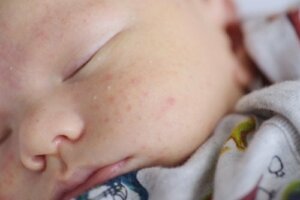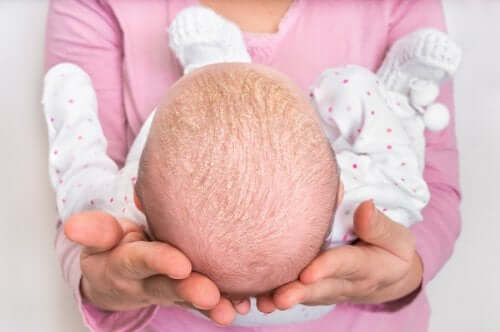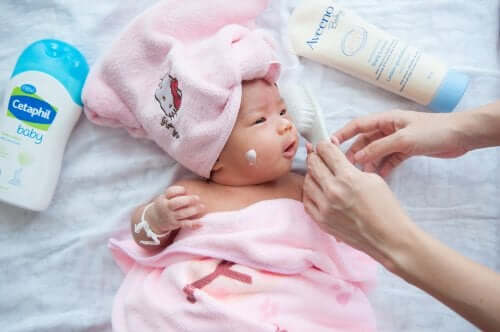How to Treat Cradle Cap and Baby Acne

Cradle cap and baby acne are skin conditions that appear early, practically from birth.
Cradle cap mainly affects a newborn’s scalp. However, it can spread to the face, mainly to the center of the face and the folds around the nose, behind the ears, neck, navel, armpits, or groin.
Cradle cap is a rash characterized by red scaly patches. They may be covered in oily-looking yellowish patches. The patches are painless or itchy. Although they can be difficult to remove, they’re benign and usually disappear on their own.
The causes of cradle cap

The exact causes of this condition are unknown. One of the possible causes is that the sebaceous glands of the baby’s scalp produce excess sebum.
Another possible cause, although not completely confirmed in children, could be the proliferation of some microorganisms that normally live on the skin. For example, of a type of yeast (fungus) called Malassezia.
Another factor that may play a role is genetic predisposition. However, this possibility hasn’t been studied sufficiently. In any case, this condition isn’t contagious or dangerous, nor is it caused by allergies or poor hygiene.
How to treat cradle cap
The prognosis of cradle cap is good, as it can heal on its own. Because of this, treatment shouldn’t be aggressive. The Spanish Pediatric Association recommends the following treatment options:
- Topical corticosteroids. Moderate-potency topical corticosteroids are the treatment of choice. They tend to yield results in a few days.
- Keratolytics. You can apply 3% or 5% salicylic petroleum jelly to the baby’s scalp to thin the patches. You can also apply oily substances such as olive oil. Leave them on for one to two hours and then clean them. After that, you can apply a moderate-potency corticosteroid cream.
- Shampoos. Shampoos with sulfur, zinc pyrithione, or tar can also be useful. However, it’s a good idea to individualize the treatment because they can potentially irritate the baby’s skin.
- Antifungals. Given the potential role of some fungi in this condition, you can use either an antifungal cream or shampoo, depending on the location of the patches. They usually work slower than topical corticosteroids.
- Oral corticosteroids. In very generalized and severe cases, medical professionals may prescribe oral corticosteroids.
This article may also interest you: The 6 Best Remedies for Fungal Infections of the Scalp
Hygiene measures

You can apply specific lotions, gels, non-greasy creams, or emulsions to the baby’s scalp. These products can help reduce excess sebum and inflammation. Thus, they reduce redness, calm the skin, and help the patches fall off.
To apply them correctly, you should follow these guidelines:
- Apply a small amount to the baby’s scalp. In case of facial seborrheic dermatitis, you can also apply it to the affected areas of the face. Then, gently massage the area with your fingers.
- Wash with a mild baby shampoo and rinse well so that no product remains.
It’s important to avoid scratching to reduce the risk of infection. This is because, if an infection occurs, antibiotics may be necessary.
Neonatal acne and its treatment
Neonatal acne is a condition that can develop during the first two weeks after birth. It causes the appearance of red pimples on the baby’s face, especially on the cheeks, forehead, chin, and, occasionally, also on the back.
Both the pimples and the skin around them become red. Heat or nervousness can worsen the condition. Baby acne usually goes away on its own, without any dermatological treatment, a few months after it appears.
Read on to learn more: 5 Types of Common Newborn Rashes
Hygiene recommendations for treating baby acne
The following tips can help you care for your baby’s skin while it’s affected by baby acne:
- Keep your baby’s face clean. Make sure to wash your baby’s face every day with warm water and mild baby soap.
- Dry your baby’s skin gently. Pat your baby’s skin dry.
- Don’t squeeze or rub the area affected by acne. This can cause more irritation or an infection.
- Avoid applying lotions or oils to the baby’s face.
We hope you enjoyed learning how to treat cradle cap and baby acne.
All cited sources were thoroughly reviewed by our team to ensure their quality, reliability, currency, and validity. The bibliography of this article was considered reliable and of academic or scientific accuracy.
-
Serna-Tamayo, C., Janniger, C. K., Micali, G., & Schwartz, R. A. (2014). Neonatal and infantile acne vulgaris: An update. Cutis.
-
Rapelanoro, R., Mortureux, P., Couprie, B., Maleville, J., & Taïeb, A. (1996). Neonatal Malassezia furfur pustulosis. Archives of Dermatology. https://doi.org/10.1001/archderm.132.2.190
-
Abizanda, S. S., Bautista, C. R., & Llop, F. a M. (2009). Recién nacido : cuidado de la piel. Asociación Española de Pediatria.
This text is provided for informational purposes only and does not replace consultation with a professional. If in doubt, consult your specialist.








